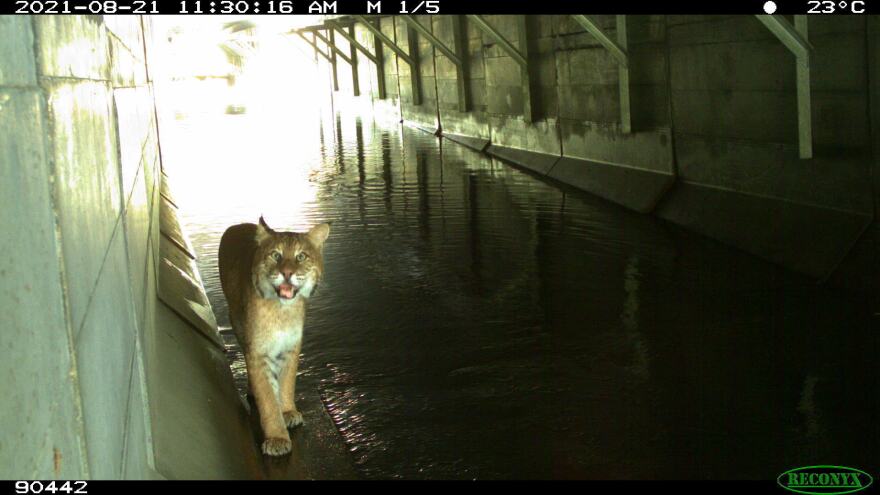LANTIER, Quebec —Valérie Bolduc is scouting a path under a four-lane highway to install wildlife cameras, when she gets stuck in the mud in the overgrown median.
"Ack, I am really stuck," says the road ecology student, trying to pull her oversized waders out of a streambed that travels through concrete culverts and the grassy median of Quebec Route 117.
Her predicament makes evident the hazards for wild animals using the same path.
"I do not want to be a deer going through that," Bolduc says.
A warming climate is pushing many animals to migrate toward higher latitudes to remain within their preferred environments, but that comes with risks as they cross dangerous areas, such as highways. In eastern Canada, not far from the U.S. border, Bolduc and other researchers and conservationists are trying to preserve safe corridors for wildlife.
"I might actually need a hand," Bolduc says at last, getting an assist from her colleague, Jaynina Deku, another student at Concordia University in Montreal.
The pair retreat through the culvert, pointing out animal tracks in the muddy edges, mostly raccoon.

The motion-activated cameras they have brought will document which species are using the concrete tunnel. An outward-facing camera will identify what animals approach but do not enter, perhaps deterred by traffic noise, the culvert's size or other factors.
"We're looking at larger megafauna," explains Bolduc, "like bear and moose ... and also just smaller, rarer species."
"Lynx," adds Deku, who once spotted the rare and reclusive animal in photos from a different research site. "Stuff like that."
Bolduc explains that this highway running diagonally through southern Quebec separates a series of Canadian national and regional parks on either side, along with their animal populations.
"It's also super important," she notes, "because of climate change. Because the animals, they want to move north and they encounter these and then can they move through? Will they get hit by a car? Will they sink and perish in the water? We'll need to figure that one out. And we need to help them, at least I want to help them."

Wildlife corridors: an idea that is hitting its stride
Wildlife corridors, an interest in conservation circles for many years, have achieved wider visibility alongside growing concern about the impacts of climate change.
"The idea," says Karen Beazley, a conservation biologist at Dalhousie University in Halifax, "is to create corridors that are relatively wide, that are relatively natural, that have as few roads and human developments as possible. And where there are those barriers to perhaps create things like underpasses and overpasses and things that will help the animals move across them."
In Banff National Park, specially created overpasses and underpasses for animals to cross the coast-to-coast TransCanada Highway have become vital and globally regarded models for preserving connectivity and supporting biodiversity. Banff falls within the Yukon to Yellowstone corridor, the focus of decades of cross-border collaboration between conservation groups and government agencies in Canada and the United States.
Researchers have estimated that species have been shifting poleward an average of around 10 miles a decade to stay within their preferred climate conditions.
For those whose range is shifting from the northeastern United States northward into Canada, "There's a real pinch point," Beazley says, "between the most Eastern Great Lake and the Atlantic Coast."

A crucial area for trans-continental migration under threat
Within that relatively narrow area, development is eating into remaining wild habitat.
Jonathan Cole, who is completing a PhD on wildlife connectivity in this region at Concordia University, has documented increasing fragmentation and steep overall declines in forest and wetland areas in the natural corridor from the Adirondack Park in northern New York State into Quebec and Ontario.
"Over the long period of time," he says, "you'll start to get major extinctions, because the species will not be able to go to where they need to go to thrive in the right environmental conditions."
He says his research has reinforced the need for collaboration between local and federal governments to ensure that animals have routes to travel in the coming decades.
"It all matters on, you know, everybody making the same decisions," he says, since most intact habitat crosses municipal or even national borders.
"Really, each municipality needs to work with their adjacent municipalities to say, 'Look, we've got this great patch here, let's try to keep that and not put roads through it.' "

It takes more than a village
Other key participants in preserving and restoring wildlife corridors include private landowners, according to Beazley. These include individuals who can commit areas of their properties to land trusts in key areas, as well as industries like agriculture and even wind energy producers.
"If governments and sectors who influence connectivity could really pick up the ball and bear connectivity in mind when they are planning where to do forestry, where to do agriculture," she says, "that's what's going to be needed to have adequate connectivity."
Transportation departments will be able to apply insights gleaned from research projects like that of Valérie Bolduc, which is being conducted in collaboration with the conservation non-profit Éco-corridors laurentiens, to modify or design new underpasses for wildlife. Fencing can also be used to direct animals to existing crossing points, with the added benefit of reducing road accidents.
Back at the highway, Bolduc and Deku finish installing their cameras on the northbound side of the highway, but decide they need an alternate path to the other side to avoid another mishap in the mud.
Using an online map, they identify a route involving a short drive to an old rail underpass turned bike path.
"We're generally trying to be safe and everything," Bolduc says, but for the animals, "this is their life!"
Copyright 2022 NPR. To see more, visit https://www.npr.org.



